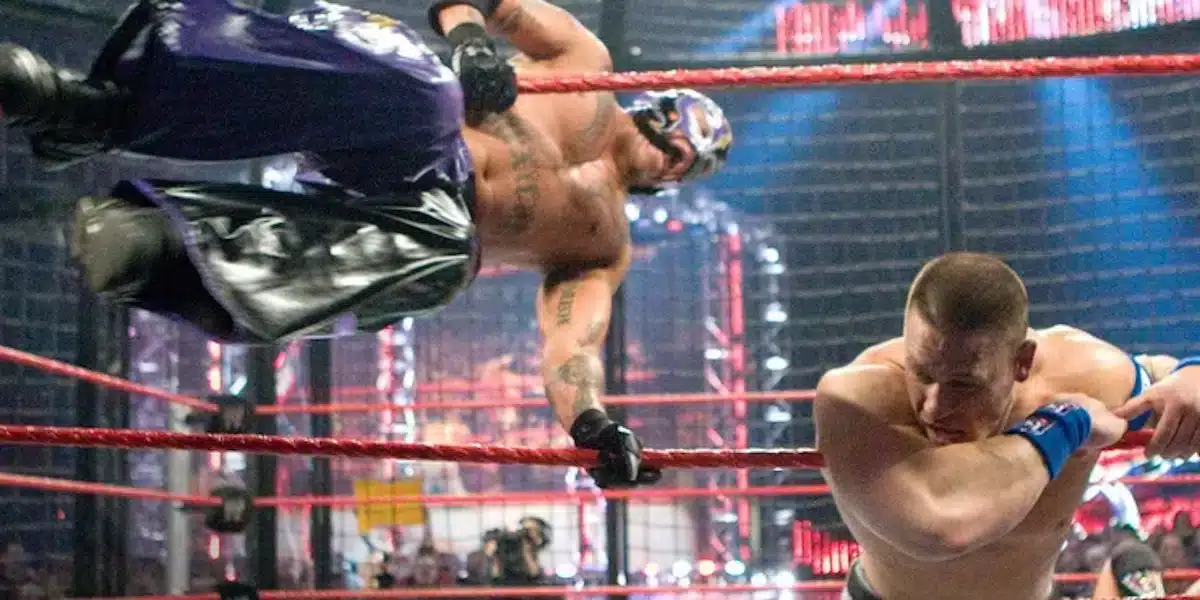Wrestling fans, get ready to dive into the world of the most famous wrestling moves and electrifying finishers in the history of professional wrestling! From the rebellious Stone Cold Stunner to the innovative 619, these moves have left an indelible mark on the industry, turning their performers into legends. Are you ready to explore the origins, techniques, and impact of these iconic, famous wrestling moves? Let’s get started breaking down our pick of the Top 35 Most Famous Wrestling Moves of All Time.
Key Takeaways
- Experience the power of wrestling’s most iconic moves like Stone Cold Steve Austin’s Stunner, Shawn Michaels’ Sweet Chin Music and The Rock’s People’s Elbow!
- Witness impressive theatrics with Bret Hart’s Sharpshooter, Triple H’s Pedigree and Undertaker’s Tombstone Piledriver & Chokeslam!
- Get ready for an electrifying show from modern finishers such as Seth Rollins’ Curb Stomp, Roman Reigns’ Spear & AJ Styles’ Styles Clash!
Stone Cold Steve Austin’s Stone Cold Stunner

The Stone Cold Stunner, popularized by Stone Cold Steve Austin, endures as a fan-favorite finisher. Its rebellious spirit and memorable moments encapsulate the Attitude Era.
Austin executes a move by grabbing his opponent’s head in a three-quarter facelock. Then, he drops down to a seated position, intending to drive their jaw into his shoulder. This devastating move, targeting the opponent’s head, has been sold wonderfully by The Rock, Triple H, and even WWE owner Vince McMahon.
The Stunner is a highly memorable finishing move in wrestling history.
Shawn Michaels’ Sweet Chin Music

Sweet Chin Music, the lethal superkick created by “The Heartbreak Kid” Shawn Michaels, is a move that combines theatrics and precision like no other. The technique involves a high-side thrust kick, also known as a Crescent Kick. To build anticipation and excitement, Michaels would tap his foot in the corner before executing the kick.
When Sweet Chin Music caught someone right on the chin as they came flying through the air, it was always a treat to witness. This finisher has cemented its place among the most revered WWE finishing moves.
The Rock’s People’s Elbow and Rock Bottom

The Rock, one of the most electrifying superstars in WWE history, has two powerful finishers: the People’s Elbow and the Rock Bottom. The People’s Elbow is an electrifying finisher that involves The Rock running the ropes before dropping a theatrical elbow on his opponent. On the other hand, the Rock Bottom is a powerful and electrifying finisher wherein The Rock scoops his opponent onto his shoulder and slams them down onto the mat with great force. Both moves demonstrate The Rock’s charisma and strength, ensuring their indelible place in his repertoire.
Bret Hart’s Sharpshooter

The Sharpshooter, a leg lock submission move invented by Japanese legend Riki Chosu, has been widely popularized by Bret “The Hitman” Hart. This technical and painful move showcases Hart’s mastery of grappling wrestling. With the opponent’s legs entwined, the Sharpshooter applies immense pressure, making even the most formidable opponents tap out.
Given its effectiveness, several wrestlers have adopted the Sharpshooter, including Natalya, Edge, and Chris Benoit.
Triple H’s Pedigree

The Pedigree, Triple H’s unique and devastating facebuster, has helped him secure numerous championships and solidify his place in WWE history. In executing the Pedigree, Triple H hooks his opponent’s arms and drives their face into the mat with great force. While the move can look sloppy in the wrong hands, few can deliver it with the same level of technique and flair as “The Game” himself.
Undertaker’s Tombstone Piledriver and Chokeslam

When it comes to invoking fear in opponents, few can match the Undertaker and his iconic moves: the Tombstone Piledriver and the Chokeslam. The Tombstone Piledriver turns the opponent upside down and drops to the knees, driving their head into the mat.
On the other hand, the Chokeslam is an iconic move where the Undertaker lifts his opponent by the throat and slams them down with great force. These powerful moves have struck fear into the hearts of opponents for decades, contributing to the Undertaker’s legendary status in WWE history.
Rey Mysterio’s 619

Rey Mysterio’s 619 is an innovative and high-flying finisher that showcases his agility and athleticism. Named after his home state, San Diego area code, the 619 involves Mysterio delivering a spinning kick to his opponent, draped over the second rope. The move can knock out multiple wrestlers simultaneously, reflecting Mysterio’s risk-taking style in the ring.
Given its innovation, the 619 is now a cherished move in contemporary pro wrestling.
Goldberg’s Spear and Jackhammer

Goldberg’s Spear and Jackhammer finishers are known for their power and high impact. The Spear involves Goldberg charging at his opponent and tackling them with maximum velocity, while the Jackhammer combines a belly-to-back mat slam and a facebuster. These moves have helped Goldberg dominate his opponents and become synonymous with his name, making them an unforgettable part of wrestling history.
Randy Orton’s RKO

The RKO, popularized by Randy Orton, is an unpredictable and exciting finisher that can come out of nowhere. The move involves Orton performing a three-quarter face lock and crashing the victim’s face onto the mat. The “RKO outta nowhere” has fueled many memes and viral videos, adding to the move’s cultural phenomenon status.
The RKO’s swift execution consistently captivates fans.
John Cena’s Attitude Adjustment

John Cena’s Attitude Adjustment is a testament to his strength and determination. The move involves Cena picking up his opponent in a fireman’s carry position and flipping them headfirst onto their back. The fireman’s carry position has been used to defeat some of the biggest names in WWE, including:
- Edge
- Randy Orton
- Chris Jericho
- Kurt Angle
among others.
Cena’s finisher has undoubtedly played a part in his rise as one of WWE’s most successful wrestlers.

Breathtaking topé suicida
This term, often used in Spanish as “suicida,” precedes any maneuver executed from any part of the wrestling ring to its exterior. A prevalent example is the ‘suicide dive’, known in Spanish as “topé suicida,” translating to “suicide headbutt.” Additionally, when a wrestler performs a somersault after springing through the ropes or leaping over the top rope to land back-first on their opponent, this move is identified as a ‘suicide senton’ or “topé con giro,” meaning “spinning headbutt” in Spanish. Outside of Mexico, this move is sometimes inaccurately called “topé con hilo,” a mistranslation that originated in Japan. This misnomer persists even though “hilo” in Spanish actually means “thread.”
High-Flying Finishers: Swanton Bomb, Shooting Star Press, and Frog Splash
High-flying finishers like the Swanton Bomb, Shooting Star Press, and Frog Splash showcase their performers’ athleticism and risk-taking nature. These aerial moves involve leaps from the top rope and require incredible precision and timing.
From Jeff Hardy’s death-defying Swanton Bomb to the thrilling Shooting Star Press performed by wrestlers like Billy Kidman and Ricochet, these moves never leave fans in awe.
Swanton Bomb
The Swanton Bomb, popularized by Jeff Hardy, is an exciting high-flying finisher that involves jumping off the top turnbuckle and performing a backflip before landing on a prone opponent. This move perfectly captures the essence of Jeff Hardy’s high-risk, high-reward wrestling style.
The Swanton Bomb is an iconic move in the world of WWE. It has brought many memorable moments, like thrilling ladder matches and high-stakes championship fights.
Shooting Star Press

The Shooting Star Press is an aerial move that involves jumping from the top rope and performing a backflip before landing on an opponent. Jushin Liger first performed this breathtaking move in August of 1987 and has since been adopted by many wrestlers, including Billy Kidman, Ricochet, and Evan Bourne.
The Shooting Star Press is truly a testament to its performers’ athleticism and daredevil nature.
Frog Splash
The Frog Splash, popularized by the late great Eddie Guerrero, is an exciting high-flying finisher that involves leaping from the top rope and landing on a prone opponent with the wrestler’s chest making contact. Many wrestlers, such as Rob Van Dam, have used the move, who added his own unique twist, calling it the Five-Star Frog Splash.
The Frog Splash remains a fan-favourite move, showcasing the wrestler’s agility and willingness to take risks in the ring.
Submission Classics: Ankle Lock, Figure Four Leglock, and Crippler Crossface
Submission moves like the Ankle Lock, Figure Four Leglock, and Crippler Crossface are about technical prowess and causing pain to force opponents to tap out. These moves have been used by some of the greatest technicians in wrestling history, such as Kurt Angle and Bret Hart.
Once locked in, these submission holds can coerce even the strongest wrestlers into submission.
Ankle Lock
The Ankle Lock, popularized by Kurt Angle and Ken Shamrock, is a submission hold involving a wrestler grabbing an opponent’s foot and twisting it to force them to tap out. The move showcases the wrestler’s technical skills and ability to immobilize opponents.
The Ankle Lock has been used to great effect by Angle throughout his career, making it an iconic part of his arsenal.
Figure Four Leglock
The Figure Four Leglock, a submission hold that involves a wrestler locking their legs around an opponent’s leg and applying pressure, was first invented by Japanese legend Riki Chosu but gained widespread popularity thanks to “The Nature Boy” Ric Flair.
This painful move targets the opponent’s legs, wearing them down and forcing them to submit. The Figure Four Leglock remains one of the most iconic submission moves in wrestling history.
Crippler Crossface
The Crippler Crossface is a technical and painful submission move that neutralizes opponents by placing them in a cross-face hold, wrenching their necks backward. This devastating move was first used by Chris Benoit and has since been incorporated into the movements of other wrestlers, such as Sasha Banks, who uses a modified version called the Banks Statement.
The Crippler Crossface is a testament to the importance of submission moves in modern wrestling, especially in professional wrestling.
Tag Team Finishers: Dudley Death Drop, Doomsday Device, and 3D
Tag team finishers like the Dudley Death Drop, Doomsday Device, and 3D showcase their respective tag teams’ fantastic teamwork and chemistry. These powerful and coordinated moves require perfect timing and execution to take down opponents in the ring.
From the Dudley Boyz’s powerful Dudley Death Drop to the Road Warriors’ renowned Doomsday Device, these finishers have significantly influenced the world of tag team wrestling.
Dudley Death Drop
The Dudley Death Drop, also known as the 3D, is an exciting tag team finishing move created by Dudley Boyz, Bubba Ray, and D-Von Dudley. The move involves one wrestler lifting the opponent into the air and slinging them over his shoulders while the other wrestler catches them with a Diamond Cutter/RKO.
The Dudley Death Drop is a testament to the innovation and excitement that tag team wrestling brings to the squared circle.
Doomsday Device
The Doomsday Device, popularized by the legendary tag team the Road Warriors (also known as the Legion of Doom in WWE), is a powerful tandem move that involves one wrestler lifting the opponent onto their shoulders. In contrast, the other wrestler jumps off the top rope and delivers a clothesline or attack.
This high-impact move showcases the incredible teamwork and coordination of the tag team and has been used by various tag teams throughout wrestling history.
3D
The 3D, another name for the Dudley Death Drop, is an innovative tag team finishing move that involves one wrestler lifting the opponent in a Flapjack. In contrast, the other wrestler hooks the opponent in a Cutter.
This move, popularized by the Dudley Boyz, has become a staple in tag team wrestling, showcasing the excitement and unpredictability of tandem finishers.
Women’s Wrestling Finishers: Charlotte Flair’s Figure Eight, Sasha Banks’ Bank Statement, and Becky Lynch’s Dis-arm-her
Women’s wrestling has also seen its fair share of innovative and effective finishers, such as Charlotte Flair’s Figure Eight, Sasha Banks’ Bank Statement, and Becky Lynch’s Dis-arm-her. These moves display the prowess and resolve of these female wrestlers, contributing to their rise to WWE’s top ranks and their dominance in the industry.
Figure Eight
Charlotte Flair’s Figure Eight is an exhilarating variation of the traditional Figure Four leg lock, adding elevation to the hold to increase pressure on the opponent. The move was invented by Charlotte herself while experimenting in the ring and has since become her signature submission move.
With its unique execution and impressive technique, Figure Eight has helped Charlotte Flair dominate her opponents and secure numerous championships.
Bank Statement
Sasha Banks’ Bank Statement is a modified version of the Crossface submission hold, which combines a cross-face and body scissors to immobilize the opponent. Sasha Banks created the move to reflect her persona and style in the ring and has become her signature finisher.
The Bank Statement showcases her technical prowess and ability to target and neutralize her opponents.
Dis-arm-her
Becky Lynch’s Dis-arm-her is a modified version of the armbar submission hold, which involves trapping the opponent’s arm between the legs and applying pressure to the shoulder. This innovative finisher has helped “The Man” rise to the top of the women’s division, showcasing her technical skills and determination in the ring.
The Dis-arm-her is a testament to Becky Lynch’s enduring legacy as one of the industry’s most exciting and innovative wrestlers.
Modern Finishers: Seth Rollins’ Curb Stomp, Roman Reigns’ Spear, and AJ Styles’ Styles Clash
In the modern era of wrestling, finishers like Seth Rollins’ Curb Stomp, Roman Reigns’ Spear, and AJ Styles’ Styles Clash have become synonymous with their respective performers, helping them rise to the top of the WWE. These distinctive, potent moves exemplify the ongoing innovation and creativity in professional wrestling, leaving a lasting impression on fans. These can be considered for inclusion in The Top 35 Most Famous Wrestling Moves of All Time.
Curb Stomp
Seth Rollins’ Curb Stomp is an artistic and powerful finisher that involves stomping on the opponent’s head while they are on their knees. This move is a testament to Rollins’ athleticism and strength, as it requires incredible precision and timing.
The Curb Stomp has become a signature move for Rollins, adding to his already impressive arsenal and helping him secure numerous championships in WWE.
Spear
Roman Reigns’ Spear is a devastating tackle that involves charging at an opponent and bringing their body forward with tremendous force. The Spear has been used by other wrestling greats such as Goldberg and Edge, but Reigns has made it his signature move.
The impact of the Spear can be devastating to the receiving end, making it a perfect finisher for “The Big Dog.”
Styles Clash
AJ Styles’ Styles Clash is a unique and innovative finisher that involves:
- grabbing the opponent’s midsection
- lifting them up
- falling forward
- driving their head and upper body into the mat
Styles accidentally created the move while playing with his brother on a trampoline during his younger days.
The Styles Clash showcases Styles’ incredible in-ring abilities and has helped him become one of the top wrestlers in the world today.
Summary of The Top 35 Most Famous Wrestling Moves of All Time
From the iconic Stone Cold Stunner to the innovative Styles Clash, wrestling finishers have left an indelible mark on the industry and its fans. These moves showcase their performers’ athleticism, creativity, and determination and create unforgettable moments that will be remembered for years. Whether it’s a high-flying aerial move or a devastating submission hold, these finishers have helped shape wrestling history and continue to inspire future generations of performers.
Frequently Asked Questions
What was Mr Perfect finisher?
Grab victory earlier than your opponent expects with Mr. Perfect’s signature finisher – the Perfect Plex, which goes directly into a pin!
What’s the rock’s signature move?
The Rock’s signature move is unmistakable: The People’s Elbow, The Samoan Drop, Rock Bottom and The People’s Eyebrow, making him one of the most recognizable wrestlers-turned-actors ever!
What is Hulk Hogan’s signature move?
Hulk Hogan is well known for his signature finishing move, the iconic “Leg Drop.” This move involves an attacking wrestler jumping and landing their leg across a fallen opponent’s chest, throat, face or head. It has become a symbol of the old-guard style that he brought into wrestling, generation after generation.
What is Booker T’s finishing move?
Booker T’s devastating finisher is a Scissors Kick, seen in action in WWE ’13!
What is the difference between a finisher and a signature move?
A finisher is a wrestler’s most potent and effective move to secure a victory. In contrast, a signature move is a wrestler’s recognizable move used regularly in matches but not necessarily for a win.
Check out our article on The Most Popular Submissions in MMA in 2023. You can also check out some finishers that you may have forgotten.
Montreal Screw Job Commemorative T-Shirt
Own a piece of WWE history with the exclusive Montreal Screw Job Commemorative T-Shirt. Featuring the iconic Survivor Series 1997 poster, this premium tee captures the controversy and drama of the unforgettable night in vibrant detail. Soft, breathable, and durable, it’s perfect for wrestling events or casual wear. Limited stock – secure yours and wear…


























